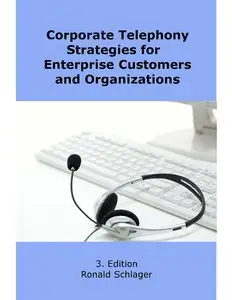Corporate Telephony Strategies for Enterprise Customers and Organizations by Ronald Schlager
English | 27 Apr. 2015 | ISBN: 151192134X | 66 Pages | True AZW4 (Kindle)/PDF (True) | 7.81 MB
English | 27 Apr. 2015 | ISBN: 151192134X | 66 Pages | True AZW4 (Kindle)/PDF (True) | 7.81 MB
The book gives you an overview of different corporate telephony strategies for your enterprise or organization to modernize your telephony and unified communications systems and to identify selection criteria.
The book covers ISDN and Voice over IP technology in a short overview.
Selecting the best fitting solution for your corporation depends on different factors and influences the future communication capabilities of the entire organization. Different solution variations are explained.
Solutions of a vendors Alcatel-Lucent, Avaya, Cisco, Huawei, Microsoft, Mitel, NEC and Unify are covered in a short overview.
Migration scenarios from traditional telephony solutions to VoIP solutions are explained.
Additionally specific strategic decisions like server strategy, device attachment, powering IP phones, coding technologies, important protocols and standard, new communication services but also network prerequisits for successful VoIP implementations are covered.
Content:
• The book covers ISDN and Voice over IP technologies in a short overview.
• Typical characteristics of existing enterprise telephony solutions for corporations of different sizes are explained.
• An overview of Voice over IP covers the general concept of the technology, advantages, challenges, relevant standards and typical building blocks are explained.
• The book discusses different strategies you may follow to establish enterprise-wide Voice over IP services and the challenges you may be faced.
• The book covers following strategies:
• Chapter "Do nothing" or "upgrade your existing systems" are the first explained strategies.
• Chapter "On-Premises Solutions" discusses the characteristics of solutions you install in your environment.
• Chapter "Free and Open Source Solution" gives a short overview of available software (like Asterisk, FreePBX or others).
• Chapter "Hosted / Co-location solution" explains the characteristics of such services and who should consider them.
• Chapter "Cloud solution" explains the differences to hosted services and the characteristics.
• Chapter "Mobile Centrex" explains the characteristics, the differences to premises solutions and the main advantages.
• Chapters "Solution of Alcatel-Lucent Enterprise, Avaya, Cisco, Huawei, Microsoft, Mitel, NEC, Unify" provide a short description of the vendor´s solutions.
A link collection listing the names of vendors of telephony and UC&C (Unified Communications & Collaboration) solutions helps you to find the right contact.
• Chapter "Implementing Voice over IP" describes in general how Voice over IP may be implemented.
• Chapter "Integration of existing Telephony Solutions" describes strategies to integrate traditional PABX infrastructure.
• Chapter "Networking and Architectural Requirements" describes the prerequisites of your network.
• Chapter "Server Strategy" covers single server and multiple server environments.
• Chapter "Strategy for Provider Access" explains the new SIP trunking access.
• Chapter "Attachment of End Devices" describes characteristics of workplace attachments.
• Chapter "Power Supply of End Devices" covers Power over Ethernet variations.
• Chapter "Signalling" describes the main differences of SIP and ITU-T H.323.
• Chapter "Coding Technology" presents different narrowband and broadband codecs and their impact to voice quality. • Chapter "Applications - Unified Communications" gives a short overview of the services supported in modern VoIP solutions.
• "The Future of (Telephony) Communications Services" identifies the next communication services coming soon.
• A brief checklist helps to identify important selection criteria.
Books in these formats look like real PDF, with good pictures and tables!
You can download on your any Kindle devices (Kindle Paperwhite, Kindle Fire HDX, Kindle Voyage, Kindle Keyboard, Kindle Wireless) and then open the eBook to read.
For reading on your PC (Windows XP / Vista / Windows 7 / XP x64 / Vista 64 / Windows7 x64 / Windows 8 / Windows 8 x64) you must register an account on Amazon, after download and install Kindle for PC from Amazon:
ht...-10&keywords=for+PC
or download installation file direct from NitroFlare:
http://nitroflare.com/view/47F...8/KindleForPCx64-installer.exe
If you want read eBooks on your Android device, you can download Kindle for Android from Play Market:
https://play.google.com/store/apps/details?id=com.amazon.kindle
or download installation file direct from NitroFlare:
http://nitroflare.com/view/BA6...Amazon%2BKindle_4.13.0.203.apk
Kindle for Mac you can found and download here:
https://itunes.apple.com/us/app/kindle/id405399194?mt=12
http://www.amazon.com/Amazon-D...mp;sr=8-10&keywords=for+PC
If you would like reading kindle eBooks on your iPhone or iPad, you need download an Kindle for iOS:
https://itunes.apple.com/md/ap...584613?mt=8&ign-mpt=uo%3D4
You can download on your any Kindle devices (Kindle Paperwhite, Kindle Fire HDX, Kindle Voyage, Kindle Keyboard, Kindle Wireless) and then open the eBook to read.
For reading on your PC (Windows XP / Vista / Windows 7 / XP x64 / Vista 64 / Windows7 x64 / Windows 8 / Windows 8 x64) you must register an account on Amazon, after download and install Kindle for PC from Amazon:
ht...-10&keywords=for+PC
or download installation file direct from NitroFlare:
http://nitroflare.com/view/47F...8/KindleForPCx64-installer.exe
If you want read eBooks on your Android device, you can download Kindle for Android from Play Market:
https://play.google.com/store/apps/details?id=com.amazon.kindle
or download installation file direct from NitroFlare:
http://nitroflare.com/view/BA6...Amazon%2BKindle_4.13.0.203.apk
Kindle for Mac you can found and download here:
https://itunes.apple.com/us/app/kindle/id405399194?mt=12
http://www.amazon.com/Amazon-D...mp;sr=8-10&keywords=for+PC
If you would like reading kindle eBooks on your iPhone or iPad, you need download an Kindle for iOS:
https://itunes.apple.com/md/ap...584613?mt=8&ign-mpt=uo%3D4



